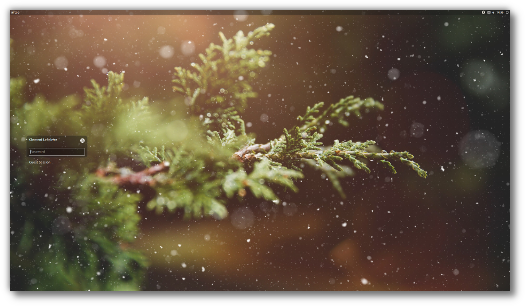A slick-looking LightDM greeter
- The default configuration is stored in dconf under the schema x.dm.slick-greeter.
- Distributions should set their own defaults using a glib override.
- Users can create and modify /etc/lightdm/slick-greeter.conf, settings in this files take priority and overwrite dconf settings.
A configuration tool is available at https://github.com/linuxmint/lightdm-settings
- Slick-Greeter is cross-distribution and should work pretty much anywhere.
- All panel applets are embedded. No external indicators are launched or loaded by the greeter.
- No settings daemon are launched or loaded by the greeter.
- This greeter supports HiDPI.
- Sessions are validated. If a default/chosen session isn't present on the system, the greeter scans for known sessions in /usr/share/xsessions and replaces the invalid session choice with a valid session.
- You can take a screenshot by pressing PrintScrn. The screenshot is saved in /var/lib/lightdm/Screenshot.png.
- Slick Greeter started as a fork of Unity Greeter 16.04.2, a greeter developed for Ubuntu by Canonical, which used indicators and unity-settings-daemon.
Configuration file format for /etc/lightdm/slick-greeter.conf
# LightDM GTK+ Configuration
# Available configuration options listed below.
#
# activate-numlock=Whether to activate numlock. This features requires the installation of numlockx. (true or false)
# background=Background file to use, either an image path or a color (e.g. #772953)
# background-color=Background color (e.g. #772953), set before wallpaper is seen
# draw-user-backgrounds=Whether to draw user backgrounds (true or false)
# draw-grid=Whether to draw an overlay grid (true or false)
# show-hostname=Whether to show the hostname in the menubar (true or false)
# show-power=Whether to show the power indicator in the menubar (true or false)
# show-a11y=Whether to show the accessibility options in the menubar (true or false)
# show-keyboard=Whether to show the keyboard indicator in the menubar (true or false)
# show-clock=Whether to show the clock in the menubar (true or false)
# show-quit=Whether to show the quit menu in the menubar (true or false)
# logo=Logo file to use
# other-monitors-logo=Logo file to use for other monitors
# theme-name=GTK+ theme to use
# icon-theme-name=Icon theme to use
# font-name=Font to use
# xft-antialias=Whether to antialias Xft fonts (true or false)
# xft-dpi=Resolution for Xft in dots per inch
# xft-hintstyle=What degree of hinting to use (hintnone/hintslight/hintmedium/hintfull)
# xft-rgba=Type of subpixel antialiasing (none/rgb/bgr/vrgb/vbgr)
# onscreen-keyboard=Whether to enable the onscreen keyboard (true or false)
# high-contrast=Whether to use a high contrast theme (true or false)
# screen-reader=Whether to enable the screen reader (true or false)
# play-ready-sound=A sound file to play when the greeter is ready
# hidden-users=List of usernames that are hidden until a special key combination is hit
# group-filter=List of groups that users must be part of to be shown (empty list shows all users)
# enable-hidpi=Whether to enable HiDPI support (on/off/auto)
# only-on-monitor=Sets the monitor on which to show the login window, -1 means "follow the mouse"
[Greeter]
